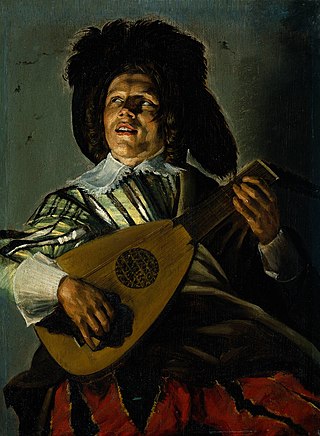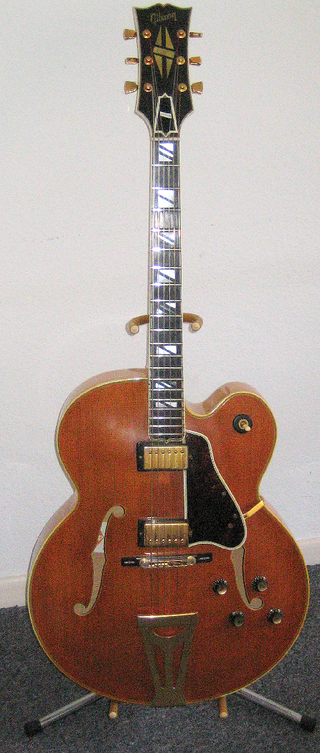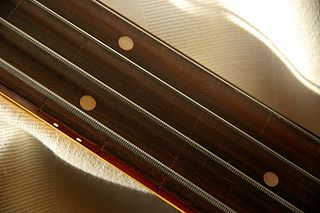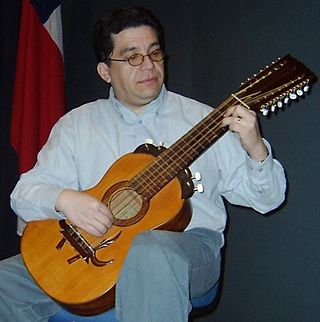
The bass guitar, electric bass or simply bass is the lowest-pitched member of the guitar family. It is a plucked string instrument similar in appearance and construction to an electric or acoustic guitar, but with a longer neck and scale length. The bass guitar most commonly has four strings, though five- and six-stringed models are also relatively popular, and bass guitars with even more strings or courses have been built. Since the mid-1950s, the bass guitar has largely come to replace the double bass in popular music due to its lighter weight, the inclusion of frets in most models, and, most importantly, its design for electric amplification. This is also because the double bass is acoustically compromised for its range in that it is scaled down from the optimal size that would be appropriate for those low notes.

The sitar is a plucked stringed instrument, originating from the Indian subcontinent, used in Hindustani classical music. The instrument was invented in the 18th century, and arrived at its present form in 19th-century India. Khusrau Khan, an 18th-century figure of the Mughal Empire has been identified by modern scholarship as the inventor of the sitar. According to most historians, he developed the sitar from the setar, an Iranian instrument of Abbasid or Safavid origin.

C.F. Martin & Company is an American guitar manufacturer established in 1833 by Christian Frederick Martin. It is highly respected for its acoustic guitars and is a leading manufacturer of flat top guitars and ukuleles. The company has also made mandolins and tiples, as well as several models of electric guitars and electric basses, although none of these other instruments are still in production.

Recitative is a style of delivery in which a singer is allowed to adopt the rhythms and delivery of ordinary speech. Recitative does not repeat lines as formally composed songs do. It resembles sung ordinary speech more than a formal musical composition.

The Appalachian dulcimer is a fretted string instrument of the zither family, typically with three or four strings, originally played in the Appalachian region of the United States. The body extends the length of the fingerboard, and its fretting is generally diatonic.

Squier is an American brand of electric guitars owned by Fender. The former manufacturing company, established as "V. C. Squier Company" was founded in 1890 by Victor Carroll Squier in Battle Creek, Michigan, producing strings for violins, banjos, and guitars. In 1965, the company was acquired by Fender.

In music, a serenade is a musical composition or performance delivered in honour of someone or something. Serenades are typically calm, light pieces of music. The term comes from the Italian word serenata, which itself derives from the Latin serenus. Sense influenced by Italian sera "evening", from Latin sera, fem. of serus "late".

An archtop guitar is a hollow acoustic or semi-acoustic guitar with a full body and a distinctive arched top, whose sound is particularly popular with jazz, blues, and rockabilly players.

Karl Höfner GmbH & Co. KG is a German manufacturer of musical instruments, with one division that manufactures guitars and basses, and another that manufactures other string instruments, such as violins, violas, cellos, double basses and bows for stringed instruments.
D'Addario is a family-owned and operated American multinational company that specializes in musical instrument accessories, headquartered in Farmingdale, Long Island, New York.

In music, strings are long flexible structures on string instruments that produce sound through vibration. Strings are held under tension so that they can vibrate freely, but with control. This is to make the string vibrate at the desired pitch, with looser strings producing lower pitches, and tighter strings producing higher pitches. However, a vibrating string produces very little sound in of itself. Therefore, most string instruments have a sounding board to amplify the sound.
D major is a major scale based on D, consisting of the pitches D, E, F♯, G, A, B, and C♯. Its key signature has two sharps. The D major scale is:
E minor is a minor scale based on E, consisting of the pitches E, F♯, G, A, B, C, and D. Its key signature has one sharp, on the F. Its relative major is G major and its parallel major is E major.

Christian Tetzlaff is a German violinist who has performed internationally, with a focus on chamber music.

An experimental musical instrument is a musical instrument that modifies or extends an existing instrument or class of instruments, or defines or creates a new class of instrument. Some are created through simple modifications, such as cracked cymbals or metal objects inserted between piano strings in a prepared piano. Some experimental instruments are created from household items like a homemade mute for brass instruments such as bathtub plugs. Other experimental instruments are created from electronic spare parts, or by mixing acoustic instruments with electric components.
The six String Quartets, Op. 76, by Joseph Haydn were composed in 1797 or 1798 and dedicated to the Hungarian count Joseph Georg von Erdődy (1754–1824). They form the last complete set of string quartets that Haydn composed. At the time of the commission, Haydn was employed at the court of Prince Nicolaus Esterházy II and was composing the oratorio The Creation as well as Princess Maria Hermenegild Esterházy's annual mass.

The Piano Quartet No. 3 in C minor, Op. 60, completed by Johannes Brahms in 1875, is scored for piano, violin, viola and cello. It is sometimes called the Werther Quartet after Goethe's The Sorrows of Young Werther. The premiere took place in Vienna on November 18, 1875, to an anxious public. Richard Wagner and his wife Cosima were in attendance.

The Guitarrón Chileno is a guitar-shaped plucked string instrument from Chile, with 25, 24 (rarely), or even 26 strings. Its primary contemporary use is as the instrumental accompaniment for the traditional Chilean genre of singing poetry known as Canto a lo Poeta, though a few virtuosi have also begun to develop the instrument's solo possibilities.

Jeremy Miles Ferguson, better known by the stage name Jinxx, is an American musician best known as the rhythm guitarist and violinist of the rock band Black Veil Brides.
Ning Feng is a Chinese violinist. He was born in Chengdu, China, and is based in Berlin.














